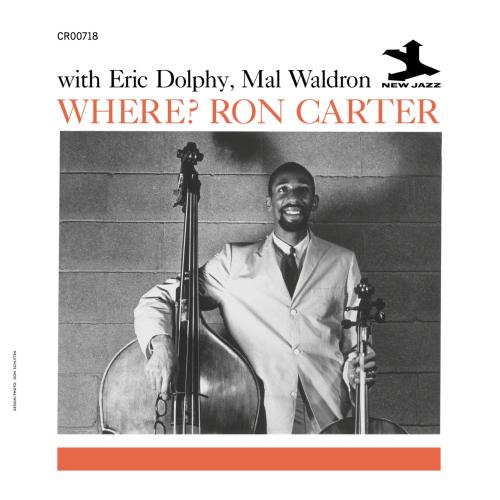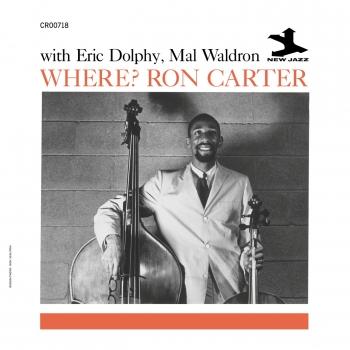
Where? (Remastered 2024) Ron Carter, Eric Dolphy, Mal Waldron
Album info
Album-Release:
2024
HRA-Release:
29.03.2024
Album including Album cover
I`m sorry!
Dear HIGHRESAUDIO Visitor,
due to territorial constraints and also different releases dates in each country you currently can`t purchase this album. We are updating our release dates twice a week. So, please feel free to check from time-to-time, if the album is available for your country.
We suggest, that you bookmark the album and use our Short List function.
Thank you for your understanding and patience.
Yours sincerely, HIGHRESAUDIO
- 1 Rally (Remastered 2024) 05:41
- 2 Bass Duet (Remastered 2024) 05:42
- 3 Softly, As In A Morning Sunrise (Remastered 2024) 07:36
- 4 Where? (Remastered 2024) 06:00
- 5 Yes, Indeed (Remastered 2024) 05:50
- 6 Saucer Eyes (Remastered 2024) 05:07
Info for Where? (Remastered 2024)
Bass player Ron Carter’s debut album Where? features Eric Dolphy (clarinet, sax, flute) and Mal Waldron (piano). The album was originally released in 1961 having been recorded at Rudy Van Gelder Studios in New Jersey. This reissue features remastered audio from the original master tapes and is available on 96/24 hi res digital.
"Carter and Dolphy had played together in Chico Hamilton's group and on Dolphy's important 1960 date Out There. Where? has elements in common with both, but is closer to Hamilton's late-'50s chamber jazz than to the more outward-bound Dolphy date. ... Carter's skill is undeniable, but his playing on Where? is a bit polite and monochromatic. ...Dolphy -- playing bass clarinet, alto sax, and flute -- is a far more interesting prospect, even if he doesn't blow his face off to the extent he did in other settings" (Jim Todd, AMG)
Ron Carter, double bass (tracks 2, 3, 6), cello (tracks 1, 4 & 5)
Eric Dolphy, alto saxophone (track 3), bass clarinet (track 1), flute (tracks 5 & 6)
Mal Waldron, piano
George Duvivier, double bass (tracks 1, 2, 4 & 5)
Charlie Persip, drums
Recorded June 20, 1961 at Van Gelder Studio, Englewood Cliffs, NJ
Engineered by Rudy Van Gelder
Produced by Esmond Edwards
Digitally remastered
Please Note: We offer this album in its native sampling rate of 96 kHz, 24-bit. The provided 192 kHz version was up-sampled and offers no audible value!
Ron Carter
The epitome of class and elegance, though not stuffy, Ron Carter has been a world class bassist and cellist since the ’60s. He’s among the greatest accompanists of all time, but has also done many albums exhibiting his prodigious technique. He’s a brilliant rhythmic and melodic player, who uses everything in the bass and cello arsenal; walking lines, thick, full, prominent notes and tones, drones and strumming effects, and melody snippets. His bowed solos are almost as impressive as those done with his fingers. Carter has been featured in clothing, instrument, and pipe advertisements; he’s close to being the bass equivalent of a Duke Ellington in his mix of musical and extra-musical interests. Carter’s nearly as accomplished in classical music as jazz, and has performed with symphony orchestras all over the world. He’s almost exclusively an acoustic player; he did play electric for a short time in the late ’60s and early ’70s, but hasn’t used it in many, many years.
Carter began playing cello at ten. But when his family moved from Ferndale, MI, to Detroit, Carter ran into problems with racial stereotypes regarding the cello and switched to bass. He played in the Eastman School’s Philharmonic Orchestra, and gained his degree in 1959. He moved to New York and played in Chico Hamilton’s quintet with Eric Dolphy, while also enrolling at the Manhattan School of Music. Carter earned his master’s degree in 1961. After Hamilton returned to the West Coast in 1960, Carter stayed in New York and played with Dolphy and Don Ellis, cutting his first records with them. He worked with Randy Weston and Thelonious Monk, while playing and recording with Jaki Byard in the early ’60s. Carter also toured and recorded with Bobby Timmons’ trio, and played with Cannonball Adderley. He joined Art Farmer’s group for a short time in 1963, before he was tapped to become a member of Miles Davis’ band.
Carter remained with Davis until 1968, appearing on every crucial mid-’60s recording and teaming with Herbie Hancock and Tony Williams to craft a new, freer rhythm section sound. The high-profile job led to the reputation that’s seen Carter become possibly the most recorded bassist in jazz history. He’s been heard on an unprecedented number of recordings; some sources claim 500, others have estimated it to be as many as 1,000. The list of people he’s played with is simply too great to be accurately and completely cited. Carter’s been a member of New York Jazz Sextet and New York Jazz Quartet, V.S.O.P. Tour, and Milestone Jazzstars, and was in one of the groups featured in the film Round Midnight in 1986.
He’s led his own bands at various intervals since 1972, using a second bassist to keep time and establish harmony so he’s free to provide solos. Carter even invented his own instrument, a piccolo bass. Carter’s also contributed many arrangements and compositions to both his groups and other bands. He’s done duo recordings with either Cedar Walton or Jim Hall. Carter’s recorded for Embryo/Atlantic, CTI, Milestone, Timeless, EmArcy, Galaxy, Elektra, and Concord, eventually landing at Blue Note for LPs including 1997’s The Bass and I, 1998’s So What, and 1999’s Orfeu. When Skies Are Grey surfaced in early 2001, followed a year later by Stardust, Carter’s tribute to the late bassist Oscar Pettiford. In 2006 another tribute album was released, Dear Miles, dedicated to Miles Davis, also on Blue Note. (Ron Wynn, AMG)
This album contains no booklet.










